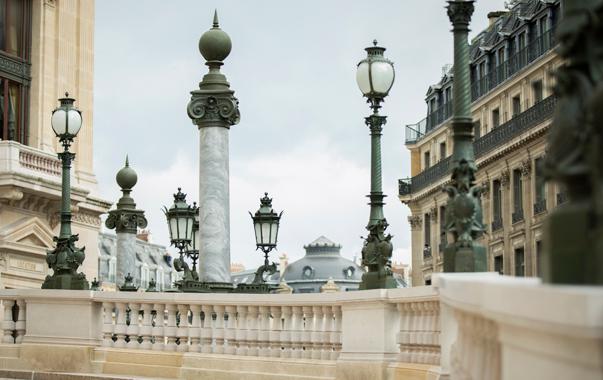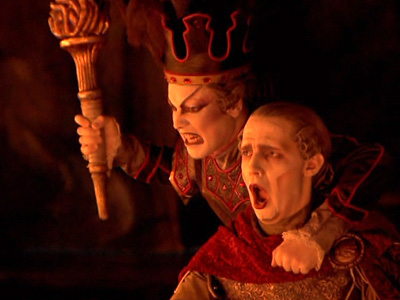By: Frank Cadenhead
Since 2008, the world economies have been flat. Governments have managed to maintain the appearance of “business as usual” but world-wide graphs of economic activity have been just plugging along without any noticeable uptick. What this means is that every town, region and country in the Western world have been struggling to balance their books at the end of the financial year in the face of increasing demands, subtile inflation and flat receipts. When roads need repair and hospitals need additional staff, the arts budget, however sacred in Europe, sometimes pays the price.
One of France’s most famous exports, besides foie gras, has been the original-instruments group Les Arts Florissants and their renowned leader, William Christie. For a couple of decades, he and “Les Arts” have had a home for part of the year in Caen, in the north of France. The Ministry of Culture made an effort to decentralize music activity from being concentrated in Paris and did this by designating a major part of their budget to regional and city governments. These entities also contributed a minor share and have played host to many musical groups. The groups are active with local conservatories and impacted the community in a variety of ways. One major bonus was, for the lucky citizens of Caen, to see the Les Arts Florissants productions before their sold-out appearances in Paris, London or New York. The end of this subvention meant little to Les Arts Florissant, already with a significant base in Paris, and some were undoubtedly happy to avoid the frequent travel north. Their budget has grown over the years and the loss of a half-million euros in receipts was not significant.
The following year it was the turn of the second most-known French baroque group, Les Musiciens du Louvre and their popular leader Marc Minkowski who had been spending a part of their year in Grenoble, at the foot of the French Alps. Like Les Arts Florissants, they too are well established in Paris and Minkowski was more and more away with his conducting career. The orchestra’s reduced activity in Grenoble was not too harmful and they still occasionally perform there and retain their local visibility.
This year, it is the turn of baroque ensemble Le Concert d’Astrée and their leader, Emmanuelle Haïm. Last month it was revealed that the city of Lille, which has hosted this group that is partnered with their opera company, cut their current budget 25% and the regional government sliced 40% off their contribution. This sent the group reeling and trying to find a way to keep their schedule which, like most other internationally honored orchestras, projects out two or three years.
What can these baroque orchestra do? Cutting the number of musicians is a body blow to these groups. Unlike symphony orchestras with some possibility to reduce the full time total number, these chamber groups are already just the right number of instrumentalists needed and their choirs are lean too. Administrative staffs are already at the minimum and reducing the number of performances reduces the ticket income.
With the decline in public support, the private sector seems an obvious source. The problem is that French arts organizations, like their German counterparts, have a long history of government support for their activities and their experience in raising private funds is, literally, non-existant. American groups have an entire department dedicated to fund-raising and this is often half or more of the total number of staff, apart from the talent. They have multi-year plans, skilled fund-raisers on the payroll and wide community outreach. French organizations usually have none of this and the French public has little experience supporting the arts.
There are some exceptions but they generally prove the rule. The Aix-en-Provence Festival, for example, has almost no support at all from any government, local or national, and their budget is made up of ticket sales and corporate sponsorship. There are individuals who write a check also at Aix, as with other arts organizations, but this is usually a very small part of any financial picture in France. Stéphane Lissner, whose fund-raising abilities kept the Aix-en-Provence Festival thriving, was a new sort of arts leader Europe needed.
His talents created a miracle when, in 2005, he was brought in to save the iconic La Scala Opera of Milan, teetering on the brink of collapse. He restored it with world-class artistry but also knew how to make the La Scala “brand” attractive for Italian companies who provided the support the government withheld. He is now in his second year as head of the Paris Opera and the challenges of restoring that company to the top level of world opera. Can he make the La Scala miracle work for the Paris Opera?
 There was a toe in the water even before he arrived. A multi-year restoration project of the Opéra’s Palais Garnier was finished and the exterior gleams like new in the sun. A little hole in the plan was that funds were used up before the restoration of the belt of sixty major light fixtures Charles Garnier installed around the exterior of the house. The Opéra announced an “Adopt a Light Fixture” program to cover this cost and it was, surprising everyone, oversubscribed by more than 50%.
There was a toe in the water even before he arrived. A multi-year restoration project of the Opéra’s Palais Garnier was finished and the exterior gleams like new in the sun. A little hole in the plan was that funds were used up before the restoration of the belt of sixty major light fixtures Charles Garnier installed around the exterior of the house. The Opéra announced an “Adopt a Light Fixture” program to cover this cost and it was, surprising everyone, oversubscribed by more than 50%.
We can see a bit of the new when Lissner, last month, announced his new “Third Stage,” a place on the opera’s website for short videos by independent filmmakers on the subject of opera. The international jewelry name, “Van Clef & Arpels,” is featured prominently on the opening page.
But it is never easy at the Opéra de Paris. Just this week, it was discovered that an employee who happens to be a union representative, was using his company portable phone while he was on vacation in Spain in July and August. Frequent travelers know how the extraordinary cost of “roaming charges” can add up but this guy was apparently unaware. Using his phone constantly to speak to others in the union racked up an astonishing 52,000 euros ($57,000 dollars).
What he was undoubtedly talking about that summer was the impending strike action by the unions of the Opéra de Paris. The September 5 opening night of Madame Butterfly at the Opera Bastille and the opening night of Platée of Rameau at Palais Garnier September 7 were both canceled by strikes and tickets were either refunded or exchanged. It is reported that these two events cost the opera something like 400,000 euros in lost revenue. Negotiations are still ongoing but no strikes have been announced for the immediate future.
But, in any case, a loss like that has to have an impact on the bottom line and two items in the media in the last few days show that the public can be interested in these budget issues. The first opera cost features a ton and a half Charolais steer who makes an appearance in the new production of Schoenberg’s opera, Moses und Aron. This impressive animal, named “Easy Rider,” was seen, with his two costumed handlers, in the second act as a vague representative of the biblical “Golden Calf” in the libretto. The cost of his travel up from Sologne in the center of France, his care and feeding and his appearances on the Bastille stage were listed as some forty-thousand euros. Many lovers of opera often do not want to know the reality of what these elaborate spectacle, which run only for a few weeks, might actually cost. It has always been and will remain, an uncomfortable subject. The Minister of Culture acknowledged receiving a petition objecting to the use of live animals in opera production which has some 21,000 signatures.
As was written in our Musical America story, http://tinyurl.com/nd8dc6e, another petition is gaining signatures for an even hotter subject. The Palais Garnier, one of the two Paris houses of the Opéra and, unsurprisingly, a certified French historical monument, was the subject of some interior tampering. Major partitions were put on rails so that they could be moved so that 30 extra seats could be added and sold. The two levels of loges facing the stage have been altered and when these partitions are removed, on however a temporary basis, the “before” and “after” image is sad.
Growth for European economies would not only make more people rich, but it would increase government revenue and begin to ease the long term stress for many performing arts groups which depend on government support.
